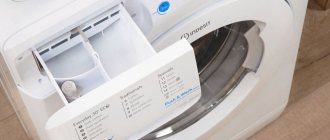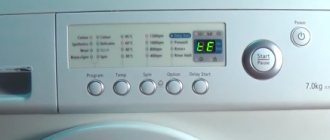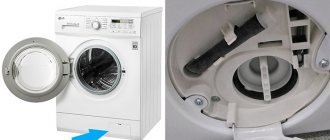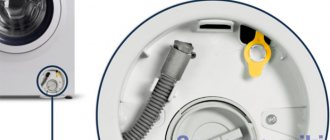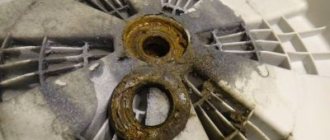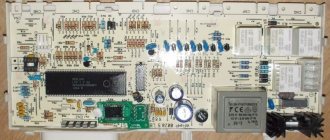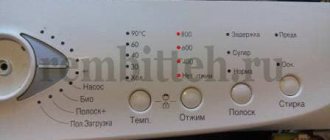Simple reasons
There are many reasons why such a defect may occur. Any mechanism tends to wear out, and the parts included in the design of washing machines are also no stranger to this.
The human factor also plays a significant role: the owner’s attitude towards the equipment, how carefully he operates and cares for it. Quite often the causes of noise are very banal.
Incorrect installation
If even a new machine is installed incorrectly, owners will quickly realize that it is not working properly. This will be especially pronounced in the mode with the maximum number of drum revolutions.
Before you panic, you should check whether the washer is installed correctly. To do this, you can take a level and determine how level it is. If there is a skew in one direction, it must be eliminated by moving the machine to a more level surface.
Important! Many manufacturers of washing machines have already come up with a solution to this problem: the washing machines they produce have legs at the bottom that are adjustable in height, adjusting to uneven surfaces.
With the help of these legs, there will be no problems installing the washing machine on an uneven surface.
Uneven distribution of things
If the laundry in the drum is bunched up in one pile, then the tank is strongly tilted to the side, as a result of which it begins to hit the body. Older machines are most susceptible to this problem.
If the drum rattles for this reason, then you just need to interrupt the washing process, shake the laundry, placing it evenly in the drum, and turn on the spin mode again.
Foreign object
Many people forget to check the pockets of items intended for washing. This leads to the fact that coins, buttons, screws, bones from women's underwear, etc. are washed off along with the clothes.
With each rotation of the drum, they turn over, creating a characteristic sound when they collide with its metal surface.
Important! If you suspect the presence of a foreign object in the drum that is causing noise, you must interrupt the washing process as quickly as possible and remove it.
Continuing the washing process with a foreign object inside can cause the drum to jam, and this is much more serious than just knocking.
An object has fallen into the tank
A grinding noise in an Indesit washing machine can be caused by a solid foreign object clogged in the tank. This problem is much more serious than the previous ones, since the system can simply jam at one moment. To remove the cause of the noise, you need to turn off the machine from the network and begin disassembling it.
If you do not remove an object that has fallen inside the structure in time, it can lead to breaking through the wall of the plastic tank, then you will need quite serious repairs to the SMA.
So, after the machine is de-energized, try to remove a foreign object through the hole for the heating element. To do this, do the following:
- disconnect the washing machine from the house utilities;
- provide yourself with free access to the rear wall of the case;
- remove the back cover by unscrewing the fastening screws;
- disconnect the contacts of the heating element;
- remove the retaining nut;
- Grasp the heater and, gently rocking it, remove it from the tank.
The heating element must be pulled out carefully so as not to damage the wiring.
After the heating element is removed from the housing, insert your hand into the free hole and try to remove the foreign object. If the cavity is too narrow for your hand to fit through, illuminate the hole with a flashlight and remove the desired object with wire. When you succeed in achieving your plans, you can reassemble the washing machine in reverse order and install it in its original place.
There are rarely cases when knocking in washing machines occurs due to the destruction of bearings. You can check them by removing the back wall of the case. Carefully examine the central part of the pulley. If the bearing is defective, lubricant will leak from there. Such a leak is very easy to see with the naked eye. Having discovered this malfunction, it is better not to start replacing parts yourself. The repair is classified as complex, so it is better to invite a specialist to carry out the work.
Interesting:
- Why is the drum knocking in the washing machine?
- Reviews of Indesit washing machines
- Dimensions of the Indesit washing machine
- Error codes for AEG washing machines
- Which washing machine is better Indesit or Candy
- The drum of the new washing machine is knocking
1 reader comment
- 12/16/2018 at 17:27
Olya:
The Indesit machine loaded the laundry, turned on the washing, but the hatch does not close and the washing does not proceed. To go, you need to slam the hatch tightly. This has never happened before, what could it be? Thank you!
Answer
Possible faults
If the reason for the knocking was one of the situations described above, the owner of the machine was lucky. After all, it’s much worse when any part fails - there’s no way around it without repairs.
Failures in the washing machine that cause a sound uncharacteristic of normal operation may be as follows:
- spring breakage;
- broken shock absorber;
- loose counterweight;
- worn bearings;
- network filter failure.
Each of these cases is considered separately, since they all require different repairs.
The spring is broken
The design provides for keeping the drum in a uniform state in the machine body using a spring. If the spring breaks as a result of wear, the drum moves to one side and begins to knock on the body. The knocking gets louder at high speeds.
Troubleshooting is possible by replacing the broken spring with a new one.
The shock absorber has failed
If you hear knocking and squeaking noises when washing, then most likely the cause is worn shock absorbers. Over time, they lose their elasticity and stretch.
This leads to the fact that their length allows them to reach the bottom of the machine and knock on it. In this case, it is necessary to replace the shock absorbers.
Important! Both shock absorbers need to be replaced at the same time, regardless of the fact that one of them is in good condition.
If you replace one shock absorber, the load on them will become uneven, and the second one will break in the near future.
The counterweight is loose
A counterweight in a washing machine is a weight necessary to ensure that the movable structure remains balanced during the washing process.
If the machine makes a rattling sound when spinning, it is most likely that the balancer mount is loose. The problem is eliminated by adjusting the position of the counterweight.
Bearing wear
Bearing wear is characterized not only by drum noise, but also by troubles in the form of brown spots on freshly washed laundry. Problems with bearings can arise, to a large extent, only as a result of long-term operation of the equipment. The material simply wears out, rendering the part unusable.
Important! Along with the bearings, the seals also wear out; their service life is approximately the same.
When starting a renovation, you need to change both. Since the failure of one indicates that soon they will all fail.
What do new bearings and bearings with “experience” look like?
Causes of noise when spinning a washing machine
If noise appears in the machine when the drum rotates, it is necessary to determine the cause of its occurrence. The machine is designed quite simply, but here are a number of reasons why noise occurs:
- Presence of small objects inside the machine.
- Bearing wear.
- Presence of unscrewed transport bolts. When moving and transporting a machine, many often forget to unscrew the bolts, thereby preventing the normal operation of the equipment.
- Breakage or loosening of the centrifuge rotation axis.
- Poorly secured counterweights.
- Drain pump failure.
- Incorrect installation of the machine. The washing machine is installed on an unsteady surface or is not level. These are some of the most common causes of noise.
Let's look at each of the reasons in more detail.
Foreign objects inside the machine
If the machine makes a loud noise during the spin cycle and begins to vibrate or a whistle is heard, it can be assumed that some small objects from clothing pockets have gotten into the drum. According to surveys of machine repair services, this reason is very common.
When putting things into the machine, you need to check the pockets every time, as there may be objects left there that can cause damage.
At low speeds, the washer creates virtually no vibration, so everything that gets into the drum settles at the bottom. But when the washing machine goes into spin mode, it begins to vibrate strongly and foreign objects begin to get stuck between the drum and the walls of the tank. A grinding noise appears, and machine parts can rattle and whistle, which ultimately leads to the washer breaking down.
To get out all the small things that are in the tank, you need to unscrew the heating element and, sticking your hand into the tank, pull out everything that is there.
Bearing wear
One of the most important elements in the machine are bearings; with the help of these parts the drum rotates. If there is a strong hum during the spin cycle, this may indicate that the washing machine drum is loose.
In the early stages of bearing wear, the washing machine may rattle and make extraneous noise, but later, if the problem is not corrected, the machine begins to make a lot of noise, which ultimately leads to its breakdown. Bearing wear is difficult to determine, since this will only become clear when disassembling the equipment and inspecting the part.
In order to find out whether the bearing is working properly, you need to open the door of the machine and, pressing the edge of the drum, twist it. If any slipping is felt, it can be concluded that the bearing is faulty. To fix such a breakdown, it is best to contact a repair shop, but you can try to change the bearing yourself.
Bearings rarely break. This can occur mainly due to oil seal wear or corrosion. The average life of a bearing is 10 years.
Transport bolts
If extraneous noise appears in the machine during the spin cycle, this may indicate that the transport bolts were not unscrewed when installing the washing machine. For the safe transportation of washing machines, manufacturers offer the use of special fasteners that secure the drum damping springs. If you do not unscrew them immediately, the machine may crack and rattle during the washing process.
To solve this problem, you need to remove the mounting bolts that are located on the back wall of the machine.
Breakage or loosening of the centrifuge rotation axis
The consequence of this malfunction may be clicking and vibration of the washing machine during spinning. This occurs due to the loosening of the pulley nut that secures it to the drum. When spinning, the pulley begins to dangle and hits the back wall of the machine, for this reason clicks may be heard.
To fix this problem, you need to tighten the pulley nut.
Problems with counterweight
If you hear a knocking sound in the washing machine during the spin cycle, this may indicate that the counterweights are poorly attached. These parts are necessary to balance the tank on different sides and are bolted to the tank body. When the fastenings are loosened, the counterweight hits the tank, which can cause the machine to bounce and make noise.
This failure can be solved by tightening all loose connections. To do this, you need to unscrew the back cover of the machine and tighten the screws holding the counterweights together.
Drain pump failure
Another reason for the noise could be a broken drain pump. During the spin cycle, the washing machine may suddenly hum and stop working when water enters the pump. This often happens when foreign objects get into it, which can lead to breakage of the impeller or combustion of the pump.
To eliminate this kind of malfunction, you need to stop the wash, disconnect the machine from the power supply and remove the object that got into the pump.
If the pump is already broken and cannot be repaired, you will have to replace it with a new one.
Incorrect installation of the washing machine
If during installation the machine was not placed level and it wobbles when pressed, you need to level it. At high speeds, the machine may begin to creak, and centrifugal force may create an imbalance; all this will sooner or later lead to breakdown of the washing machine. This may not be easy to do, but doing so will help avoid many problems in the future.
The problem is solved by installing the machine on a flat floor and leveling it exactly level. To do this, you will have to unscrew the legs of the machine so that it does not swing.


